| Columns Retired Columns & Blogs |
Snell Type C/V loudspeaker Measurements
Sidebar 2: Measurements
Footnote 2: Vol.17 No.7, p.139.
Despite its size, the C/V is only moderately sensitive, at a calculated 87dB/W/m (B-weighted). With its tone control set to its flat, 12 o/c position and the rear tweeter turned off, the Snell's impedance (fig.1) only drops below 6 ohms in the midrange, reaching a minimum value of 4 ohms at 450Hz. However, with the HF control at maximum and the rear tweeter turned on, the magnitude drops almost 2 ohms at 40kHz, which may be a problem with some old-fashioned tube amplifiers. The port tuning is revealed by the saddle in the impedance plot at 25Hz, implying good low-frequency extension. There are no wrinkles or discontinuities in the fig.1 traces, implying a well-braced and -damped cabinet.
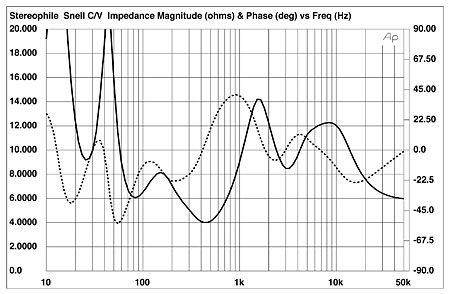
Fig.1 Snell C/V, electrical impedance (solid) and phase (dashed) with HF control set to 12 o/c and the rear tweeter off (2 ohms/ vertical div.).
Fig.2 shows the individual responses of the port, woofers, and the midrange/tweeter array. The crossover between the midrange units and woofers can be seen to be to spec at 300Hz; while the woofers have some peaks in their output, presumably due to cone break-up modes, these are well above the crossover point and are therefore suppressed. The output of the woofers peaks by up to 4dB in the midbass; the port, however, is significantly down in level. (The relative levels are plotted in the ratio of the square roots of the radiating areas.) A peak at 220Hz appears in the port's output, but this is well down in level. In the highs, the crossover between the two midrange units and the tweeter seems very well-managed, the response on the HF axis being flat-balanced until the top octave, when the tweeter starts to roll out a little early.
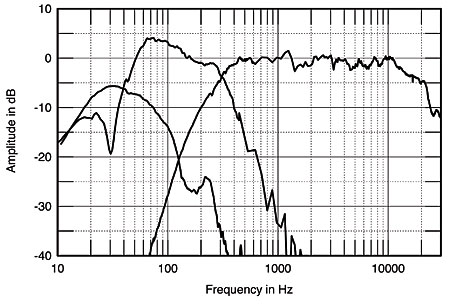
Fig.2 Snell C/V, acoustic crossover on tweeter axis at 50" corrected for microphone response, with nearfield midrange, woofer, and port responses below 550Hz, 200Hz, and 500Hz, respectively.
How all these individual responses sum on the tweeter axis at a distance of 50" can be seen in fig.3. The balance is impressively flat in that any dips below the line are both small and matched by small peaks above it. The discontinuity between 1kHz and 2kHz is a little suspicious; such a measured characteristic often correlates with a slight nasality. However, CG felt the Snell's midrange to be about the best he's heard. The slight depression in the lower midrange appears to be real, as it also shows up on room responses, but I doubt it will have any severe subjective effect. Again, CG was not bothered by any problems in this region.
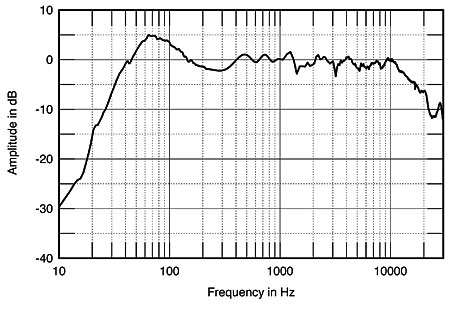
Fig.3 Snell C/V, anechoic response on tweeter axis at 50" averaged across 30° horizontal window and corrected for microphone response, with complex sum of nearfield woofer and port responses below 300Hz.
Although it will be due in part to the nearfield measurement technique, the bass hump remains a feature, and I have to agree with Corey that this blump seems to be a Snell characteristic. However, as the port output is not that high in level, this probably explains CG's satisfactory feelings about the C/V's bass. "Weighty but without boom," is what I would infer from this set of measurements, and that, indeed, is what he found. The measured –6dB point lies at a low 30Hz. While this is not quite as low as the impedance plot suggested, it is around the low B string of the 5-string electric bass. Given the usual amount of low-frequency reinforcement from the room, only those addicted to raves or organ recitals should want for more bass.
Again, there's that prematurely rolled-off top octave in fig.3. The titanium-dome tweeter used in the C/V is, I believe, sourced from JBL. While it appears to be an excellent drive-unit, I've found it to sometimes sound too sweet. Here is part of the reason for Corey's finding the C/V to lack HF air in its sound. Interestingly, while the Snell D that Tom Norton reviewed in July (footnote 2), which uses the same tweeter, did have a slight top-octave rolloff, the D's overall high treble was better balanced than the C/V when measured under identical conditions. This suggests that the titanium tweeter shows a little more sample-to-sample variation than should be the case. Perhaps Kevin Voecks would care to comment on this in his "Manufacturer's Comment." The rear tweeter (not shown) covers a narrow passband, basically reinforcing the room's reverberant field above 5kHz. I didn't find it to counteract the C/V's mellow top octave, however, at least not in the Stereophile listening room, which is where I auditioned the speakers.
The action of the C/V's tone control can be seen in fig.4. The on-axis response of the speaker with the control set to 12 o/c has been subtracted from the measured responses with it set to maximum and minimum. This reveals its behavior to be a maximum shelving up of the tweeter level by 1dB or so, or a maximum depression of 4–5dB in the audible range. Given the Snell's lack of top-octave air, this would seem to be a little too much.
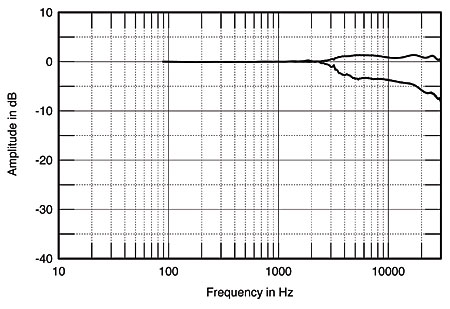
Fig.4 Snell C/V, effect of HF control set at its maximum and minimum positions, normalized to 12 o/c response on tweeter axis.
The other reason for the speaker sounding mellow can be seen in the manner in which its response changes to the sides (fig.5). Again, the on-axis response has been subtracted from these curves, and the tweeter can be seen to have very limited horizontal dispersion, its output at 10kHz being 6dB down 30° off-axis. In all but very lively or very small rooms, this will result in a mellow perceived balance. A light lack of energy in the upper crossover region appears to the speaker sides, but this is actually very good midrange dispersion for a speaker with such a wide baffle. Vertically (fig.6), listeners will get pretty much the same balance as long as they sit between the two midrange units. Standing listeners, however, will hear rather a hollow balance, due to the appearance of a lack of energy in the lower treble.
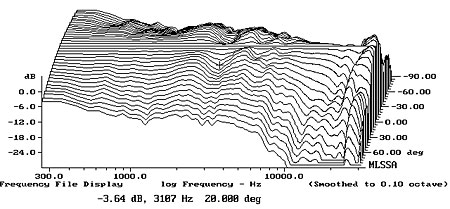
Fig.5 Snell C/V, horizontal response family at 45", normalized to response on tweeter axis, from back to front: differences in response 90°–5° off-axis; reference response; differences in response 5°–90° off-axis.
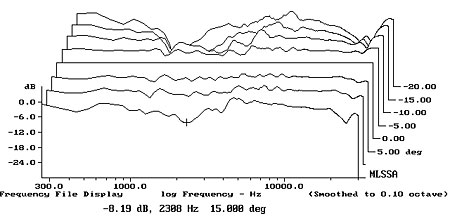
Fig.6 Snell C/V, vertical response family at 45", normalized to response on tweeter axis, from back to front: differences in response 20°–5° off-axis; reference response; differences in response 5°–10° off-axis.
In the time domain, the C/V's step response (fig.7) indicates that all its drive-units are connected with positive acoustic polarity, though, as expected from the flat baffle, there is no time alignment: the tweeter output leads that of the midranges, which in turn leads the woofers. The associated cumulative spectral-decay, or waterfall, plot (fig.8) is impressively clean in the treble—this is a very-well-behaved tweeter—but a couple of resonant modes can be seen lower in frequency: one at 3kHz and the other around 1200Hz. Nevertheless, the initial decay is clean in these regions, and CG heard nothing amiss.
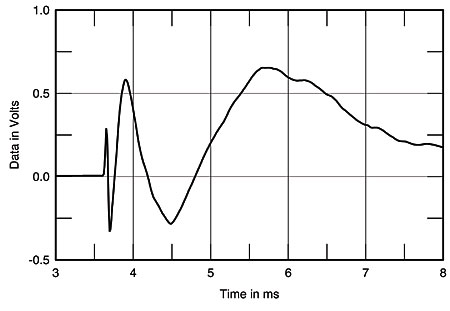
Fig.7 Snell C/V, step response on tweeter axis at 50" (5ms time window, 30kHz bandwidth).
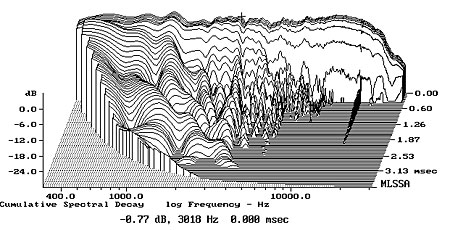
Fig.8 Snell C/V, cumulative spectral-decay plot at 50" (0.15ms risetime).
Finally, the impedance plot implied a well-behaved cabinet. This was confirmed by my calibrated version of the knuckle-rap test, in which I tape a flat polymer accelerometer to the cabinet surfaces while the speaker reproduces the MLSSA stimulus at a highish (7V RMS) level. This allows me to calculate each panel's impulse response, hence calculate a waterfall plot. The C/V's waterfall plot with the accelerometer attached to the side panel a third of the way up from the floor is shown in fig.9. Only two significant resonant modes can be seen, at 316Hz and 220Hz, but these are well down in level. This is excellent performance for a speaker with such large panel areas.
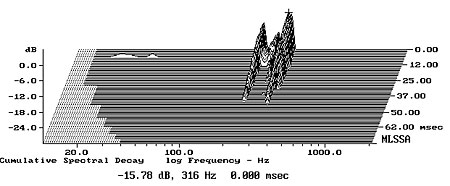
Fig.9 Snell C/V, cumulative spectral-decay plot of accelerometer output fastened to center of enclosure side panel one third of the way up from the floor. (MLS driving voltage to speaker, 7.55V; measurement bandwidth 2kHz.)
As appears to be always the case with Kevin Voecks designs, the Snell C/V offers superb measured performance. Yes, there are a couple of areas where things could be better still, but look at the price. For $2500/pair, this Snell shows many speakers twice its price a clean pair of heels.—John Atkinson
Footnote 2: Vol.17 No.7, p.139.
- Log in or register to post comments




































